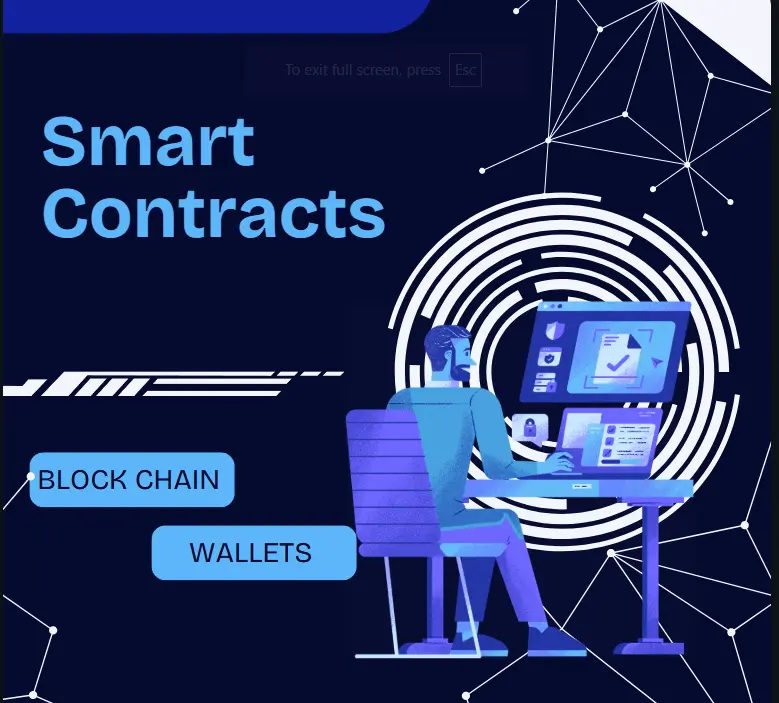Smart contracts are self-executing contracts where the terms of the agreement between buyer and seller are directly written into lines of code. They are a key feature of blockchain systems, particularly those that support decentralized applications (dApps) like Ethereum. While they offer significant benefits such as automation, efficiency, and transparency, they also introduce new security risks.
Smart contract vulnerabilities can seriously compromise the integrity of blockchain systems, resulting in financial loss, data breaches, and system manipulation. Understanding the potential vulnerabilities in smart contracts and implementing preventive measures is critical to ensuring the security, reliability, and trustworthiness of blockchain networks.
In this article, we explore how smart contract vulnerabilities affect blockchain systems and what can be done to prevent and mitigate these risks.
1. Common Smart Contract Vulnerabilities
A. Reentrancy Attacks
Reentrancy attacks are one of the most famous vulnerabilities in smart contracts, particularly after the DAO hack in 2016, which led to the theft of millions of dollars worth of Ethereum. A reentrancy attack occurs when a smart contract calls another contract and that contract calls back into the original contract before the initial execution is complete. This can allow malicious actors to withdraw more funds than they should be able to.
Example: In the DAO hack, attackers exploited this vulnerability to repeatedly withdraw funds from the contract before the contract’s state was updated, resulting in a massive financial loss.
B. Integer Overflow and Underflow
Integer overflow and underflow vulnerabilities occur when the arithmetic operations in a smart contract exceed or fall below the maximum or minimum limits allowed by the system. This can lead to unexpected results, such as an attacker being able to withdraw funds or change the state of a contract in unintended ways.
- Overflow happens when a number exceeds the maximum limit for its data type (e.g., a value exceeds 2^256 in Ethereum).
- Underflow occurs when a number goes below the minimum allowed value (e.g., a subtraction operation results in a negative value).
These vulnerabilities can be exploited to cause erroneous contract behavior and can lead to loss of assets, manipulation of contract logic, or system crashes.
C. Timestamp Dependence
Smart contracts often rely on block timestamps for executing certain operations, like determining deadlines or expiration dates. However, since miners control the timestamps of blocks, they can manipulate these timestamps within a certain range. This introduces a potential risk where an attacker might exploit this manipulation to trigger contract events at their advantage.
Example: A contract might allow a user to claim a reward after a certain block timestamp. If the timestamp is manipulated, an attacker could claim the reward earlier than expected.
D. Gas Limit and Denial of Service (DoS) Attacks
Smart contracts on platforms like Ethereum use gas to measure the computational cost of executing operations. If a contract is poorly designed, it can consume excessive gas, potentially leading to a denial of service (DoS) attack. An attacker could flood the contract with transactions that either consume all available gas or cause the contract to run out of gas, making the contract unusable.
- This could result in the contract not executing correctly, halting the operations of decentralized applications (dApps) relying on it.
- Attackers can exploit this by deliberately creating expensive transactions that block the contract from executing.
E. Front-Running and Order Dependency
Front-running occurs when a user or attacker anticipates a transaction and executes a competing transaction before the original one can be processed. This is particularly problematic in decentralized finance (DeFi) applications, where users compete for the best trade opportunities or block space.
- Attackers can use bots to monitor the blockchain for pending transactions and submit their own transactions with higher gas prices to gain priority, leading to unfair competition and loss of funds for other participants.
2. The Impact of Vulnerabilities on Blockchain Systems
Smart contract vulnerabilities not only undermine the security and integrity of the blockchain itself but can also have significant economic and reputational consequences for users, businesses, and developers.
A. Financial Loss
The most direct impact of smart contract vulnerabilities is financial loss. If an attacker can exploit a vulnerability, they can steal funds from the contract or manipulate contract logic to their advantage. This can result in millions of dollars in losses, as evidenced by the DAO hack and numerous other attacks on DeFi protocols.
B. Loss of Trust
A compromised smart contract undermines the trust of users and investors in the entire blockchain ecosystem. If users fear that their funds or data could be stolen due to vulnerabilities in smart contracts, they are less likely to adopt blockchain-based services. A loss of trust can lead to reduced adoption, regulatory scrutiny, and a damaged reputation for blockchain projects and developers.
C. Network Instability
Smart contract vulnerabilities can also cause disruptions or instability in blockchain-based applications. If a contract is unable to execute correctly due to a bug or attack, it can halt operations or cause cascading failures across other smart contracts or applications that depend on it. This can destabilize entire networks, particularly in high-value ecosystems like decentralized finance (DeFi), where many contracts interact with each other.
3. Preventive Measures to Address Smart Contract Vulnerabilities
To ensure the security and integrity of blockchain systems, developers and organizations must implement best practices and preventive measures to mitigate smart contract vulnerabilities.
A. Rigorous Code Audits and Formal Verification
Code audits are one of the most effective ways to detect vulnerabilities in smart contracts before they are deployed on the blockchain. Independent auditors or teams should review the code for common vulnerabilities like reentrancy, integer overflows, and timestamp dependence. Using automated tools and manual review processes can help identify potential flaws.
- Formal verification is another advanced method where smart contract logic is mathematically proven to behave as expected. Formal verification tools analyze the code’s logic and guarantee that the contract will always perform as intended, even in edge cases.
Tools:
- Mythril: A security analysis tool that identifies security vulnerabilities in Ethereum smart contracts.
- Slither: A static analysis framework that helps detect vulnerabilities like reentrancy, gas limit issues, and uninitialized state variables.
B. Use of Safe Math Libraries
To prevent integer overflow and underflow issues, developers should use established safe math libraries, which automatically handle arithmetic operations and prevent values from exceeding or falling below the permissible range. For instance, OpenZeppelin provides a well-established safe math library that can be integrated into Ethereum-based smart contracts.
- These libraries implement checks to ensure that overflow or underflow cannot occur during mathematical operations.

C. Implementing Proper Access Control
Access control mechanisms ensure that only authorized entities can perform critical actions within a smart contract. Developers should implement role-based access control (RBAC) or multisignature wallets to limit who can execute sensitive functions, such as withdrawing funds or modifying contract logic.
- Multisig contracts require multiple parties to sign off on a transaction, reducing the likelihood of a single point of failure and making it harder for attackers to exploit vulnerabilities.
D. Timelocks and Emergency Stop Mechanisms
Incorporating timelocks and emergency stop (circuit breaker) mechanisms can help mitigate the damage caused by an attack. A timelock prevents funds from being withdrawn or transferred before a certain period, giving developers time to respond to suspicious activity. An emergency stop function can halt contract execution if an anomaly is detected.
- Upgradable contracts can also allow the contract owner to upgrade or modify the code in case of a discovered vulnerability, ensuring that quick fixes are possible.
E. Limit Dependence on Block Timestamps
Since block timestamps can be manipulated by miners, smart contracts should not depend heavily on timestamps for crucial logic like expiration dates or deadlines. Instead, it is better to use block numbers or external oracles to derive time-sensitive data.
- Oracles provide external data to the blockchain in a trusted manner, ensuring that critical contract decisions are based on accurate, tamper-proof information.
F. Testing and Simulation
Before deploying a smart contract on the mainnet, developers should conduct thorough unit testing, integration testing, and simulation on testnets. These tests can help identify edge cases and unforeseen vulnerabilities that may not be apparent during the initial development phase.
- Testnets like Rinkeby or Ropsten allow developers to test their contracts in a safe environment without risking real funds.
- Fuzz testing is another technique used to input random or unexpected data into a smart contract to detect vulnerabilities that might not be apparent through traditional testing.
Conclusion: Securing Smart Contracts for a Safer Blockchain Future
While smart contracts are one of the most revolutionary features of blockchain technology, they are not without risk. Vulnerabilities such as reentrancy attacks, integer overflows, timestamp manipulation, and DoS attacks can severely impact the security and reliability of blockchain systems, resulting in financial loss, loss of trust, and network instability.
To mitigate these risks, developers must follow best practices such as rigorous code audits, using safe math libraries, implementing proper access control, and ensuring that contracts are well-tested. Furthermore, formal verification, timelocks, and emergency stop mechanisms can be used to provide additional layers of protection.
As blockchain technology continues to evolve, ensuring the security of smart contracts will be crucial for fostering trust in decentralized applications and realizing the full potential of blockchain across industries. By adopting a proactive approach to security, developers can help minimize vulnerabilities and contribute to the creation of more secure and resilient blockchain ecosystems.
















































